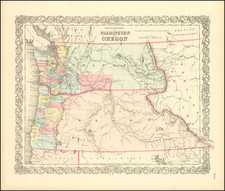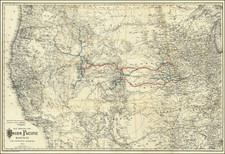Unrecorded Wall Map of Bozeman, Montana
Detailed wall map of Bozeman, Montana, "Compiled and Drawn from Official Records by C.M. Thorpe C.E. Bozeman" .
The map shows the city and quite importantly, its continually updated water and sewer system, for which Thorpe was a central character in the early 20th Century.
The map provides a remarkably detailed accounting the streets, rail lines, subdivisions, and public and private facilities with the City of Bozeman. Larger tracts of land are identified by land owner. A large swath of land through the middle of town is still reserved "for Railroad purposes."
The Explanation Key at the top left notes:
- Vacated Streets and Alleys
- Water Mains
- Sewers
- Street Car Lines
- City Limits
- Ward Boundaries
- Fire Limits ("One Block Each Side of Main St. From Ida Ave. to Fifth Ave.")
The map appears to have been created with a photographic process, directly onto drafting linen.
C.M. Thorpe & Bozeman's Water System
Supplying water to Bozeman was, from the start, an engineering challenge. After Bozeman’s founding in 1864, domestic water sources varied from public fountains, Bozeman Creek and wells on private property. Following its incorporation in 1883, creating a safe and useful infrastructure became an issue of immediate import. Initially, this issue was handled in partnership with the private sector, with investor given a license to create a distribution system on public property, in exchange for the water source, infrastructure and billing support, with the city retaining the right to purchase the system in 15 years.
After 2 failed attempts, the “Bozeman Water Works Company” received a license to supply, maintain and operate water works, water mains, pipes and fire hydrants within the city, utilizing Lyman Creek as the primary source. Water rights were acquired from Nelson Story, who used some of the water to power his milling operation. The finished system moved water from the springs at Lyman Creek in wooden pipes under the East Gallatin River and into the City Limits.
By October 1898, Bozeman had voted to purchase the rights through the issuance of bonds. By 1905 nearly 23 miles of wooden and cast iron pipes delivered water from Lyman Springs to the city. As the population grew, so did its water needs.
By 1908, City Engineer C.M. Thorpe sought out alternative water sources south of town, which could run downhill to service College Hill, also called College Heights. In 1908 Thorpe reported on Mardis Springs, located 2.75 miles south of town near the modern intersection of South 3rd Avenue and Goldenstein Lane. Thorpe found no well defined spring, but that the water rose over an area of swampy ground and offered a flow of 18 to 22 inches. Though Mardis Springs wasn’t perfect, Thorpe thought an ample water supply could be developed in the area. Over the course of the next several years, the reservoir capacity was increased and new private ventures significantly increased water deliveries.
One project undertaken in this time frame was thea dam at Mystic Lake in 1903 and 1904. City Engineer CM Thorpe was the Construction Engineer. Thorpe frequently subsidized his salary as Engineer for the City by moonlighting in the private sector. Using skills honed as a Surveyor for Gallatin County, Thorpe surveyed Mystic Lake in preparation for construction of the 43 foot high and 400 foot long dam.
Rarity
We locate no record of the map in OCLC or in any other on-line resource.










![[ Wall Map of Montana Territory ] Map of the State of Montana. Compiled from the official Records of the General Land Office and other sources . . . 1897](https://storage.googleapis.com/raremaps/img/small/98232.jpg)



![[Idaho and western parts of Wyoming & Montana--including Yellowstone and Tetons] Amer. Sep. No. 39. Partie Des Etats-Unis](https://storage.googleapis.com/raremaps/img/small/93545.jpg)